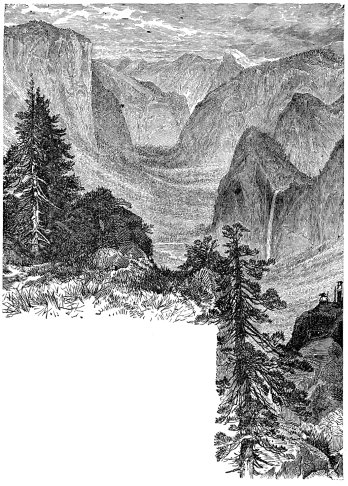
[click to enlarge]
| Online Library: | Title | Author | California | Geology | History | Indians | Muir | Mountaineering | Nature | Management |
Yosemite > Library > Where to Go & What to Do > Chapter 2. Notes in General About Yosemite. >
Next: 3. Cataracts of Yosemite • Contents • Previous: 1. Roads to Yosemite
Location.—The Yosemite Valley lies in the County of Mariposa (Spanish word for Butterfly), in the east central part of California. Its situation is a little south of east from San Francisco. It is well up on the western slope of the Sierra Nevada mountains, the crest of that range being from twenty-five to thirty miles eastward from the Valley. The level of the Valley is a trifle less than 4000 feet above the sea.
Discovery.—As far as is known by authentic evidence the Valley was first seen by white men on the 5th or 6th day of May, 1851. [Editor’s note: The correct date is March 25, 1851 (from a diary entry of Pvt. Robert Eccleston). The dates in May refer to a second expedition to Yosemite Valley.—dea.] ] The discoverers were a party of volunteer soldiers, led by a Major Jas. D. Savage. This force was pursuing a band of hostile Indians and came to the edge of the Valley, on its southern side near the lower end, quite unexpectedly. It appears, however, that some indistinct intimation of a strange and deep caņon in the mountains had previously been given by Indians in conversation with white men. The discovery attracted little attention at the time, the members of the military force seeming not to have fully appreciated the rare magnificence on which they had fallen. Some account of the grandeur of the scenery did nevertheless go abroad, and small parties of sight-seers found their way into the Valley from that time forward.
Early Settlers.—The regular settlement of the Valley began in 1857, when two men—S. M. Cunningham, who is now keeper of the Mariposa Big Tree Grove, and another named Beardsley—put up a rough building to serve for a trading post and hotel. Other hotel buildings followed as travel increased. The original house was taken apart and removed long ago.
The first permanent settler in the Valley was Jas. C. Lamon. At least he was the first person to remain in the Valley throughout the year. An old cabin that was occupied by him still stands in the upper part of the Valley under Glacier Point, and there is near by a fine apple orchard that was planted by Lamon. He died in 1875, and was buried not far from the foot of the Yosemite Fall, a granite monument marking the grave.

[click to enlarge] |
Names.—The name Yosemite means a large grizzly bear. [Editor’s note: it means “they are killers.” For the correct origin of the word Yosemite see “Origin of the Word Yosemite.”—dea.] It was the name of the tribe of Indians who occupied the Valley when discovered. About a dozen of them still live there. The name was suggested by Dr. L. H. Bunnell, who was a member of the force that made the discovery. The name is pronounced in four syllables (Yo-sem-i-te) with the accent on the second syllable. The Indian name for the Valley was Ahwahnee. Nearly all the more noticeable places in the Valley had names given to them by the Indians, but the right sound and the meaning of most of these names have become matters of guess-work or imagination. Few of them are used in this book, as they merely tend to confusion.
General Character.—The Valley is a chasm or gorge—what the Spanish-Americans would call a caņon—of extraordinary depth, and with walls that approach a vertical formation to a singular degree. The average height of the walls is little less than 3000 feet, while in many places they exceed that figure by several hundred feet, and one part (the Half Dome) rises to an elevation of nearly 5000 feet. The sides of the Valley are not regularly continuous. There are bold, projecting angles and deep gaps through which torrents of water descend to the level of the Valley’s floor.
Dimensions.—In length the space reckoned as the Valley proper is something over seven miles. The width of the nearly level floor varies from less than a quarter of a mile to three-quarters of a mile. At the bottom of the walls there are heaps of fragmentary rock. Measuring the distances between the walls above this debris or talus, the Valley is in places about two miles wide and from that down to half a mile. The official measurements of the Valley’s area give a sum of 8480 acres. Of these 3109 acres are given as meadow land.
Floor of the Valley.—This consists of alternate stretches of open meadow and woodland. It is said that when the Valley was first visited by white men the open space was much greater than it now is. The Indians then made a practice of burning all young vegetable growth in order to facilitate their hunting. Since the occupation by whites the fires have been stopped, and in parts of the Valley dense thickets of young pines and other trees have sprung up. Formerly the floor of the Valley was open for all persons to go and come in whatever course they might choose. Of late years a number of enclosures for pastures have been made. One of these is set apart for the free use of horses belonging to camping parties. A well-constructed road runs around the full extent of the floor, and branches lead to Mirror Lake and the Cascade Falls. Altogether the road covers twenty-one miles.
Rivers and Creeks.—The Valley is traversed from end to end (its general trend being from northeast to southwest) by the Merced River—River of Mercy. This stream has its head-source in the snows of Mount Lyell, some thirty-five miles from the Valley. It empties into the San Joaquin river at a point in the northern part of the great plains of that name.
The Merced is joined at the upper end of the Valley by Tenayah Creek, which comes down from Tenayah Lake, about ten miles away by the course of the stream. This creek supplies the water of Mirror Lake and then passes on to its union with the Merced.
The Yosemite Creek, the Bridal Veil Creek, and several streams also empty into the Merced in the Valley. Most of them, however, have a flow of water during but a few months in the year, when the snows of the high Sierra are melting.
Mirror Lake.—This little body of water has a world-wide celebrity. Simply as a lake, nevertheless, it is not peculiarly interesting. In the fall of the year it becomes a mere pond of dark water. Earlier in the season, when it is more expansive and deeper, it has great attractiveness, due to its surroundings. Its situation is in the Tenayah Caņon, here formed by the vertical face of the great Half Dome and by the base of the North Dome on the opposite side. Looking higher up the caņon, Cloud’s Rest shows itself at the right hand and Mt. Watkins at the left. When the surface of Mirror Lake is quite still, the reflections of the overlooking heights are very distinct. This effect is at its best in ‘the morning before the day breeze has arisen, and travelers usually time their visits accordingly. The place, however, is one at which many days may be passed pleasurably by people prolonging their sojourn in the Valley. The echoes from the prodigious cliffs here are wonderfully clear and numerous.
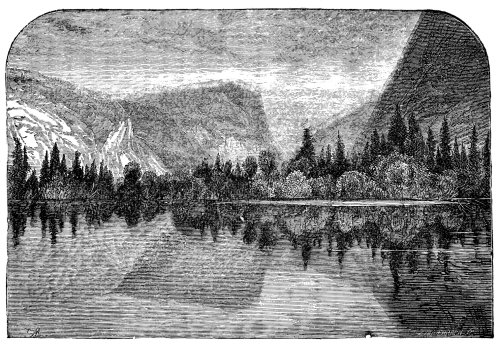
[click to enlarge] MIRROR LAKE. |
Trees.—Scattered over the floor of the Valley is an abundant growth of large and handsome oak, pine and other trees. There is a quite common impression among people who have not visited the Valley that it contains what are by usage known as Big Trees. There is, in fact, no representative of that kind (Sequoia gigantea) in the Valley. The location of the Big Trees is mentioned elsewhere. The largest tree in the Valley is said to be a red spruce (Abies Douglasii) which stands near the southern end of the Tenayah bridge, and which measures twenty-eight feet in circumference at the base.
The more numerous trees in the Valley are the following: Black Oak (Quercus Kelloggii), Live Oak (Quercus Chrysolepis), Dwarf Oak (Quercus Dumosa), Sugar Pine (Pines Lambertiana), Yellow Pines (P. Jeffreyi and P. Ponderosa), Douglas Spruce (Abies Douglasii), Silver Firs (A. Concolor, A. Grandis and A. Nobilis), Red Cedar (Libocedrus Decurrens), Rock Maple (Acer Macrophyllum), Quaking Aspen (Populus Tremuliodes), Balm of Gilead (Polulus Balsamifera), Alder (Alnus Veridis), Dogwood, (Cornus Nuttallii), Laurel (Umbellularia Californica), California Nutmeg (Torreya Californica.) There are specimens of Tamarack (P. Contorta) and of Juniper (Juniperus Occidentalis) in places overlooking the Valley.
Shrubs.—There is a large variety in the greater and smaller bush growth, but the following are the more common representatives of that class: Azalea (A. Occidentalis), California Lilac (Ceanothus Integerrimus), Manzanita (Arctostaphylos Glauca)—the latter grows all over the mountains, and is very noticeable on account of its oddly contorted red stems and olive-green leaves; Wild Coffee (Rhamnus Californica), Elderberry (Sanbucus Glauca), Chokecherry (Prunus Demissa), Serviceberry (Amelonchier Alnifolia), Blackberry (Rubus Ursinus), Raspberry (Rubus Cacodermis), Thimbleberry (Rubus Nutkamus), Gooseberry (Ribes Meziessii), Currant (Ribes Sanguineum), Spirea Discolor, Spice plant, (Calycanthes Occidentalis,) Wild Rose (Rosa Californica), Buckeye (Aesculus Californica.) The latter, like the Manzanita, is characteristic of California, and appears on all the roads from the foothills to the Valley. In the spring and early summer it is very observable, the white stems, broad and brilliant leaves, and long plumes of white blossoms, making an attractive combination of colors.
There are a few grapevines in the Valley, and in one place a cat-tail swamp—near the Black Spring on the road to Cascade Falls.
Flowers and Ferns.—A lady who passed a summer in the Valley kindly furnished the writer with the following list of flowering plants. It does not by any means comprise the names of all the flowers to be found there, but will give a good idea of their great variety.
| Amsinckia Spectabilis—Wheat Thief. | Hosackia Crassifolia. |
| Aquilegia Truncata—Columbine. | Heliotropium Curassavictum. |
| Anterrhinum Vagans—Snapdragon. | Iris Macrosephon. |
| Anterrhinum Glandlosum—Snapdragon. | Lupinus Microcarpus—Lupin. |
| Apocynum Cannabinum—Indian Hemp. | Lupinus Nanus—Lupin. |
| Asclepias Fascicular—Milk Weed. | Lupinus Stiveri—Lupin. |
| Asarum Candatum—Ginger. | Lupinus Albicaulis—Lupin. |
| Brunella Vulgaris—Self Heal. | Lilium Pardalinum—Tiger Lily. |
| Brassica Campestris—Mustard. | Lilum Parvum. |
| Brodiaea Laxa | Conicera Hispidula—Honeysuckle. |
| Brodiaea Gracilis. | Conicera Involucrata—Honeysuckle. |
| Clarkia Elegans. | Mimulus Tricolor—Monkey Flower. |
| Clarkia Rhomboidea. | Mimulus Douglasii—Monkey Flower. |
| Claytonia Perfoliata—Indian Lettuce. | Mimulus Cardinalis—Monkey Flower. |
| Calochortus Venustus—Mariposa Lily. | Mimulus Lutens—Monkey Flower. |
| Collinsia Bicolor. | Mimulus Moschatus—Musk Flower. |
| Collinsia Tinctaria. | Mentha Canadensis—Mint. |
| Collinsia Parviflora. | Monardella Undulata. |
| Castilleia Parviflora—Painted Cup. | Nemophila Insignis—Baby Eyes. |
| Castilleia Parviflora—Prince’s Plume. | Nuphar Polysepalum—Yellow Pond Lily. |
| Convolvulus Cal.—Creeping Morning Glory. | Oenothera Biennis—Evening Primrose. |
| Oxalis Corniculata—Yellow Sorrel. | |
| Coreopsis. | Penstemon Laetus—Beardtongue. |
| Capsella Divaricata—Shepherd’s Purse. | Pyrolo Picta. |
| Chimaphila Umbellata—Pipsissewa. | Pterosphora Andromeda. |
| Cuscata—Dodder. | Ranunculus Californica—Buttercup. |
| Dodecatheon Meadia—Shooting Star. | Ranunculus Alismaefolius. |
| Dicentra Formosa—Bleeding Heart. | Sarcodes Sanguinea—Snow Plant. |
| Delphinum Simplex—Larkspur. | Spraguea Umbellata—Pussy’s Paws. |
| Delphinum Cal.—Larkspur. | Symphoricarpus Racemosus—Snowberry. |
| Delphinum Decarum—Larkspur. | Scutellaria—Skullcap. |
| Eritrichium—White Forget-me-not. | Stachys Chamissonis. |
| Eryodictyon Glutinosum—Mountiain Balm. | Trifolium Ciliatum—Clover. |
| Erodium—Alfilerilla, Pin Clover. | Trifolium Videntatum—Clover. |
| Frogaria Californica—Strawberry. | Trifolium Microcephalium—Clover. |
| Godetia Lepida, G. Hispadula, G. Quodrivulnara. | Viola Canina—Blue Violet. |
| Viola Aurea—White Violet. | |
| Gilia Biniflora, G. Pusilla, G. Californica, G. Aurea, G. Dichtoma. | Vicia Gigantea—Vetch. |
| Vicia Exigua—Tare. | |
| Geranium Incisum—Goldenrod. | Yarrow. |
| Graphalium—Immortel. | Zauschneria Californica—Fuchsia. |
The many kinds of ferns to be found in the Valley, or near to it, form one of the minor charms of the place. The common brake (Peris Aquilina) grows very abundantly over most parts of the floor, and attains a height of several feet. In the autumn it assumes a richly varied coloring. The following is a list of the fern family of the Valley, a few names being on the authority of Mr. J. W. Hutchings’ “In the Heart of the Sierras.”
| Adiantum Capillus-Verneris—Venus Hair. | Pellaea Andomedaefolia—Heather Leaved Brake. |
| Adiantum Emarginatum—California Maiden Hair. | Pellaea Wrightiana—Wright Cliff Brake. |
| Adiantum Pedatum—Foot-stalked Maiden Hair. | Pellaea Brachyptera—Short-winged Cliff Brake. |
| Aspidium Aculeatum—Sharp-leaved Shield. | Pellaea Ornithopus—Bird’s Foot Cliff Brake |
| Aspidium Aculeatum Scopulorum—Sierra Shield. | Pellaea Densa—Dwarf Cliff Brake. |
| Aspidium Munitum—Armed Shield. | Pellaea Bridgessi—Bridge’s Cliff Brake. |
| Aspidium Munitum Nudatum—Naked Shield. | Pteris Aquilina—Common Brake. |
| Aspidium Munitum Imbricans—Over-lapped Shield. | Phegopteris Alpestris—Alpine Beech. |
| Asplenium Filix faemina—Lady Fern. | Polypodium Vulgare—Common Poly. pody. |
| Cryptogramme Acrostichoides—Rock Brake. | Polypodium Cal.—Cal. Polypody. |
| Cheilanthes Californica—Cal. Lip. | Woodsia Oregana—Oregon Woodsia. |
| Cheilanthes Gracillima—Graceful Lip. | Woodsia Scopulina—Hairy Woodsia. |
| Cheilanthes Myriophilla—Many-leaved. | Woodwardia Radicans—Greek Chain. |
| Cystopteris Fragilis—Fragile. | Botrychium Simplex—Simple Grape. |
| Gymnogramme Triangularis—Golden Back. | Botrychium Ternatum Australe—Three-parted Grape. |
| Pellaea Breweri—Brewer’s Cliff Brake. | Botrychium Virgiananum—Virginia Grape. |
| Ophioglossum Vulgatum—Adder-tongue. |
Wild Animals.—Bears are common in the surrounding mountains, and occasionally descend into the Valley; rarely, however, until the winter has set in. Travelers in the mountains often cross bear tracks, but to see the bear itself requires skill in the hunter’s art. The grizzly, the black and the cinnamon bear are all found at times. They never interfere with travelers, preferring to keep out of man’s sight. In and around the Valley are also such animals as the fisher, coyote, mink, skunk, gray squirrel, marmot, gopher and wood-rat. Deer are kept out of the Valley by the presence of people, but in the surrounding elevations they are still quite numerous, and furnish plenty of sport for the active and persistent hunter.
Birds of many kinds swarm in the Valley. Among them are several sorts of eagles, hawks and owls. Robins are present in force, as are also larks, humming-birds, swallows, jays, thrushes and red-headed woodpeckers (Melanerpes Formicivorus). Of the industry of the last named almost every dead tree bears evidence. Holes are drilled into the trees by the woodpeckers and plugged with acorns, the excavations being made to fit the nuts so accurately that the acorns can only be got out by digging away the wood that binds them. These carpenters (for the Mexicans well call them carpinteros) can be seen at work every morning, when they wake the echoes
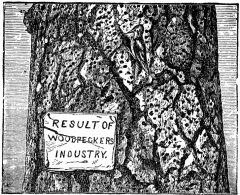
[click to enlarge] |
Game Birds are represented by the grouse and crested quail. These, however, are not often seen on the floor of the Valley, but are plentiful among the surrounding heights. The mountain quails of California are of two kinds, one being rather larger than the other, but not greatly different otherwise. There is a third variety, found in the foothills and on the plains, smaller than the mountaineers, and distinguishable by the feathers of the crest, numbering from one to six, curving forward—the crest of the mountain bird curving backward. Wild ducks also are sometimes, although rarely, seen in the Valley, but flock in large numbers on some of the lakes in the upper neighborhood.
Snakes.—There are but few of the ophidians in this region. Occasionally a rattle-snake is killed in the Valley, but the rattlers are so rare as not to be a source of disquietude to anybody. The king-snake, handsomely striped in black, white and red, and which is supposed to be a deadly enemy of the rattler, is found infrequently. It does not trouble mankind. Striped water-snakes are common, but are in no way harmful.
Fish.—There is a fair abundance of trout in the streams of Yosemite. The trout are taken with the fly, with grasshoppers, worms and a variety of other baits. The fish, however, is very wary, and visiting fishermen, as a rule, do not make large catches. The Indians dwelling in the Valley are very expert at the business, and keep the hotels supplied with trout throughout the season. They sometimes use grasshoppers or pieces of chub or sucker for bait. There are, however, white lads living in the Valley who can quite outdo the Indian fishermen in capturing the trout, and who prefer the fly-hook to any other lure.
The trout is the only fish of consequence in the waters of the Valley. There are many chub, but they are not much sought after, except for use as bait.
Hotels, Shops and Other Buildings.—There are two hotels. in the Valley. The Stoneman House was built by the State at an expense of $40,000, and opened for business in the present year, (’88.) It stands on the southern side of the upper part of the Valley, under Glacier Point. Barnard’s is at the village, not so high up the Valley as the first. There are also two hotels—Snow’s at the foot of the Nevada Falls and McCauley’s at the top of Glacier Point—which, although not in the Valley proper, form important parts of the accommodations for travelers.
The settlement in the Valley has a chapel and a school house, a postoffice, a telegraph office, a general country store, where campers can obtain anything which they are likely to need, two photographers’ rooms, a blacksmith shop, butcher shop, and that of a cabinet worker in woods. The latter is well worth a visit, as it contains many dainty and beautiful specimens of the wood worker’s art, which are always open for inspection.
The Guardian of the Valley has in the village an office, where is kept a register, on which all visitors are requested to sign their names.
The stage lines also have offices here. There is also a livery stable, where carriages and saddle or pack horses may be hired.
Camp Grounds.—For persons who prefer to make their stay in camps of their own, a ground has been set apart, with
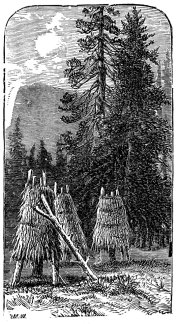
[click to enlarge] INDIAN ACORN STORES. |
Climate.—In the winter deep snows fall in the Valley, and the thermometer marks occasionally nearly down to zero, but there is much warm and pleasant weather, and the snow melts rapidly. In midsummer the mercury sometimes ranges above 80° during the hotter parts of the days, but the mornings and evenings are uniformly delightful. After the opening of the roads, in March or April, not much stormy weather is likely to be experienced by visitors. Rain storms and snow storms in the mountains which are passed over in going to the Valley, may possibly occur as late as June, so that it is well for travelers to be provided with some warm clothing or “wraps.” From the beginning of May considerable heat is probable on the road to the Valley, until the upper parts of the journey are attained. Medium clothing on the person, with some extra outside garment, in case of need, and a linen duster in summer, is the right provision.
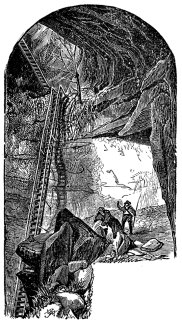
[click to enlarge] THE LADDERS—VERNAL FALLS. |
Next: 3. Cataracts of Yosemite • Contents • Previous: 1. Roads to Yosemite
| Online Library: | Title | Author | California | Geology | History | Indians | Muir | Mountaineering | Nature | Management |
http://www.yosemite.ca.us/library/mackenzie/notes.html